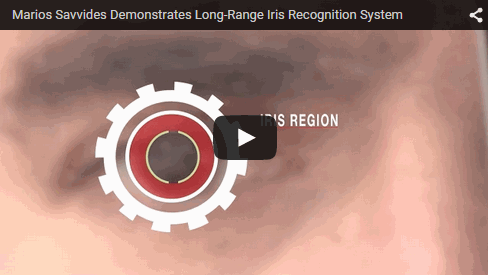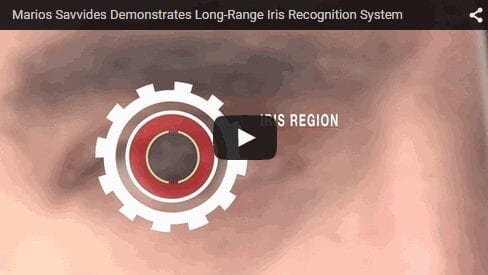
New technology allows irises to be scanned from 40 feet away. Is this a wonder weapon against crime and terrorism or a way for governments to invade our privacy and track our movements?
Imagine if you could be identified with certainty from 40 feet away by anyone with a special camera and your iris scan in a database. Carnegie Mellon researchers at the Cylab Biometrics Center have invented a device that can do that. It should definitely have criminals feeling nervous, but maybe we should all be nervous.
First the good news. According to SRI International, a spinoff of Stanford Research Institute, iris scans are 1,000 times more accurate than fingerprint scans. We’re already using handheld iris scanners in high security situations. The new Carnegie Mellon device will work up to 40 feet away — even in a mirror — so, for example, a police officer making a traffic stop can safely identify a potentially dangerous suspect before he even exits his vehicle.
The whole system works with fewer false positives than fingerprints, and it’s effective at the same general range as facial recognition. (Facial recognition famously failed during the Boston bombings because no pictures were close enough.)
Here’s the bad news. At 40 feet away, the government could now (or soon, because this version looks like it needs some focus time and for you to sit still a bit) scan crowds of people for “irises of interest” and literally troll a city street for “the bad guys.” Even the most security-minded person probably feels a little strange about that, especially when you consider that irises can be scanned passively.
For now, this isn’t a major threat because if your iris has never been scanned, no one can identify you. The FBI has at least 104 million fingerprints in its database — 70 million of which are from criminals. It has no known iris database, though it has experimented with the idea.
What if you scanned a city street daily? You may not be able to identify whom all the irises belong to, but you could say, “The same iris, which we now call Iris 543-X, walks by here at roughly the same time every day.” The assumption, then, is that Iris 543-X belongs to someone who lives or works in the area. As thousands of irises are scanned and stored, eventually a giant database could be created to track the movements of every iris that walks in front of a camera. Eventually, you’re going to identify Iris 543-X, especially if Iris 543-X can be cross-matched to facial recognition software or other forensic databases.
Read more: Iris Scans: Security Breakthrough Or Privacy Invasion?
The Latest on: Mris Scans
[google_news title=”” keyword=”Iris Scans” num_posts=”10″ blurb_length=”0″ show_thumb=”left”]
via Google News
The Latest on: Iris Scans
- Sam Altman's Worldcoin crypto is running out of 'orbs.' But what are orbs?on April 26, 2024 at 7:31 am
Worldcoin, a cryptocurrency project founded by OpenAI CEO Sam Altman that has seen rapid growth, is now running low onorbs — the devices used for iris scans in exchange for tokens. Worldcoin has ...
- Sam Altman’s Worldcoin eyeing PayPal and OpenAI partnershipson April 25, 2024 at 10:23 am
Alex Blania, the CEO of Tools for Humanity, the company behind Worldcoin, has hinted at potential collaborations with OpenAI and PayPal.
- Sam Altman’s Crypto Project Worldcoin Needs More Orbs for Sign-Upson April 25, 2024 at 12:09 am
Sam Altman's Worldcoin project is reportedly running low on orbs, the devices used for iris scans in return for tokens.
- Oh No, There's an Orb Shortageon April 24, 2024 at 6:40 pm
But Worldcoin is more than happy to push its orb scanner into other parts of the world. Tools for Humanity is obviously aware of how dystopian the entire concept sounds. And the company insists it ...
- Singapore agency develops iris biometrics gates for in-motion capture with NEC techon April 24, 2024 at 2:41 pm
The prototype was designed by HTX’s Biometrics and Profiling Centre of Expertise and uses NEC, a company that makes its own airport kiosks, for biometrics.
- Worldcoin Execs Meet Malaysian Officials Amid Global Expansionon April 24, 2024 at 2:28 pm
The meetings with Malaysian officials indicate Worldcoin’s proactive approach to working with governments and addressing regulatory issues. For what it’s worth, Ethereum co-founder Vitalik Buterin ...
- Worldcoin to Boost WLD Supply by 19% in Next Six Months, WLD Price under Pressureon April 24, 2024 at 4:03 am
Worldcoin will pump a staggering 1.5M WLD tokens every week for six months straight would lead to an increase of 36M WLD token supply.
- Iris scan for senior citizens soon? Banks look at options for verifying transactionson April 19, 2024 at 11:48 pm
Iris scanning for senior citizens at banks soon? India's commercial banks are exploring the possibility of using iris scans to authenticate transactions, particularly for their senior citizen ...
- Banks mull options on using iris scans for verifying transactionson April 19, 2024 at 11:20 am
The banks are in talks with Reserve Bank of India (RBI) among stakeholders, for using iris scans as ageing has been found to distort fingerprints or thumb impressions, making them less reliable for ...
- Worldcoin Introduces World Chain: The Layer 2 scalable Blockchain solution.on April 17, 2024 at 2:54 pm
Worldcoin now offers World Chain, a scalable blockchain solution on Layer 2 that is meant to increase efficiency with the primary emphasis on authentication through the scans of the iris and ...
via Bing News











